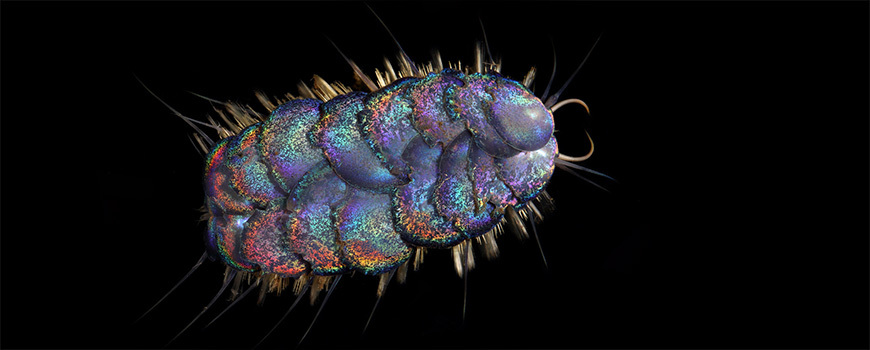Global S&T Development Trend Analysis Platform of Resources and Environment
| Hungry Hungry Scale Worms: Scientists Discover Four New Species of Deep-Sea Dwellers | |
| admin | |
| 2020-05-12 | |
| 发布年 | 2020 |
| 语种 | 英语 |
| 国家 | 美国 |
| 领域 | 资源环境 |
| 正文(英文) |  PC: Greg Rouse Researchers from Scripps Institution of Oceanography at UC San Diego have described and named four new species of scale worms from deep-sea habitats in the eastern Pacific Ocean. These deep-sea worms are known for their iridescent overlapping scales and have had the nickname “Elvis worms” for many years. Working on ships from the Monterey Bay Aquarium Research Institute, the Schmidt Ocean Institute, and the Woods Hole Oceanographic Institution, the researchers collected the worms along the eastern Pacific, including deep areas of the Monterey Canyon, the Gulf of Mexico, and Costa Rica. These new scale worms are all found in the deep sea, and have evolved to tolerate low oxygen levels by having elaborate gills under their scales. They are typically found around whale falls – the carcass of a whale that has sunk to the bottom of the ocean – and other organic remains, though one of the new species was found at a hydrothermal vent in the Gulf of California. The findings were published in the scientific journal ZooKeys May 12. The largest group of scale worms is Polynoidae and the genus for the new species is Peinaleopolynoe. The first part of the genus name is from the Greek πειναλεoσ (peinaleos), meaning hungry or famished, since the first species was found on an experimental food fall deployed in the deep Atlantic. The worms were all observed alive and collected at depth via remotely operated vehicles and the submersible Alvin. Researchers recorded an interaction between members of one of the new species P. orphanae in their natural habitat.
“For several years, it was a mystery as to why the scales of P. orphanae specimens were often drastically damaged, and we reasoned that it may have occurred during the collection process,” said Avery Hatch, a PhD student at Scripps and lead author of the study. “Now that we have observed the entertaining in situ fighting behavior of P. orphanae, we understand that these animals are actually biting off chunks of one another’s scales.” Hatch led the research that named and formally described the four new Peinaleopolynoe species, P. orphanae, P. mineoi, P. elvisi, and P. goffrediae. Peinaleopolynoe mineoi was named after the father of Scripps Oceanography Board of Directors member Chrysa Mineo, in recognition of support from the Mineo family. P. elvisi was named after the King of Rock and Roll Elvis Presley, because the iridescent golden/pink scales are reminiscent of the sparkly sequined costumes he favored in his late career. The remaining two were named after scientists Victoria Orphan, an expert in geobiology and her wife Shana Goffredi, who specializes in animal/microbial symbiosis. “Shana and Victoria are long-term collaborators and we are honored to be able to name two such spectacular new species for them in recognition of their great contributions to science,” said Greg Rouse, a Scripps marine biologist and Hatch’s mentor, who has named many new species of worms. "There are so many beautiful, fascinating, and important deep-sea worms on this planet,” said Goffredi. “I feel so honored to have one as my namesake, especially one from Monterey Canyon, where I spent much of my career as a scientist." While these worms share many anatomical features, there were very subtle morphological differences among the new species. However, DNA sequencing and analyses clearly indicate they are distinctly different species. “It is hard to believe that the deep sea is still largely unexplored and teeming with mysterious animals waiting to be discovered,” said Hatch. This study was funded by the National Science Foundation and Chrysa and Mark Mineo. The study also included a collaborator from the Observatoire Océanologique de Banyuls (France). -- Interested in naming a new species yourself? Scripps is inviting collections donors to share in the process by naming select newly discovered species acquired by the institution. The cost to name one of these, or several other newly discovered creatures, starts from $5,000. Donors receive a framed print of their named organism, as well as a copy of the official publication in which it is first described.
|
| URL | 查看原文 |
| 来源平台 | Scripps Institution of Oceanography |
| 文献类型 | 新闻 |
| 条目标识符 | http://119.78.100.173/C666/handle/2XK7JSWQ/251733 |
| 专题 | 资源环境科学 |
| 推荐引用方式 GB/T 7714 | admin. Hungry Hungry Scale Worms: Scientists Discover Four New Species of Deep-Sea Dwellers. 2020. |
| 条目包含的文件 | 条目无相关文件。 | |||||
| 个性服务 |
| 推荐该条目 |
| 保存到收藏夹 |
| 查看访问统计 |
| 导出为Endnote文件 |
| 谷歌学术 |
| 谷歌学术中相似的文章 |
| [admin]的文章 |
| 百度学术 |
| 百度学术中相似的文章 |
| [admin]的文章 |
| 必应学术 |
| 必应学术中相似的文章 |
| [admin]的文章 |
| 相关权益政策 |
| 暂无数据 |
| 收藏/分享 |
除非特别说明,本系统中所有内容都受版权保护,并保留所有权利。
修改评论